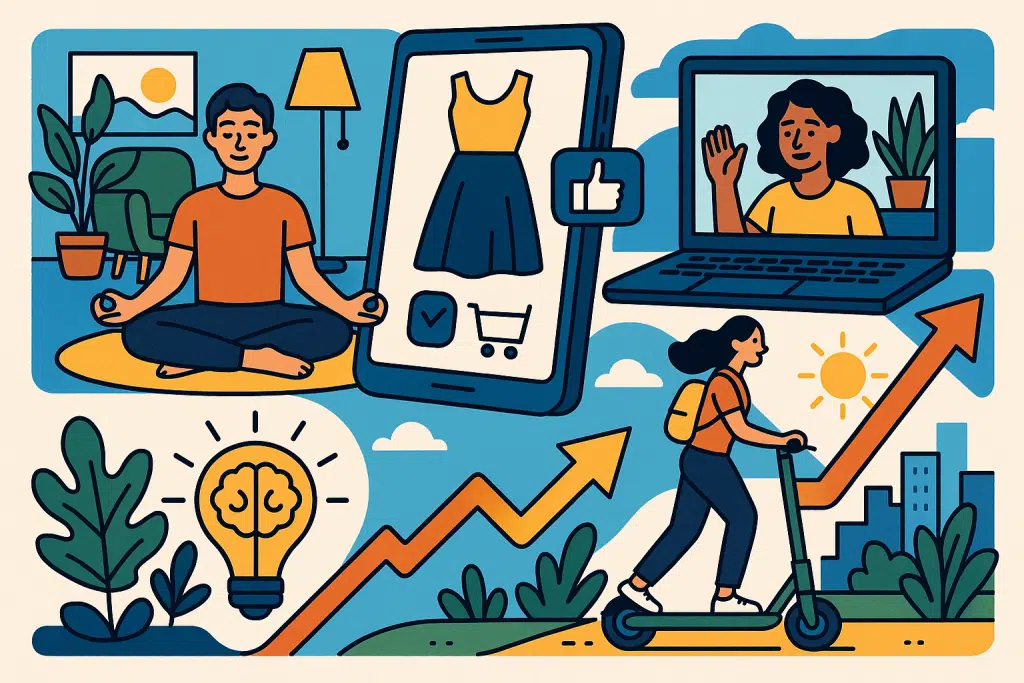Understanding Emerging Trends in Lifestyle Design
Lily Carter August 15, 2025
Lifestyle design is no longer just a buzzword—it’s an evolving blueprint for how we live, work, and connect. In 2025, emerging trends in lifestyle design are being shaped by technology, sustainability, and wellness-driven priorities. From AI-powered daily planning to regenerative living communities, these shifts are redefining our routines, values, and aspirations. Let’s explore the key trends that are transforming life as we know it.

1. Digital Minimalism 2.0: From Screen Detox to Digital Mastery
The original concept of digital minimalism—cutting back on screen time—has evolved. Now, it’s less about avoiding technology and more about curating it for intentional living. This represents a shift from reactive consumption to proactive design of our digital environments.
The first wave of digital minimalism focused on reduction: fewer apps, less social media, scheduled “digital sabbaths.” While helpful, this often created an adversarial relationship with technology. Digital Minimalism 2.0 recognizes that complete disconnection isn’t practical in our interconnected world. Instead, it emphasizes intelligent integration, where technology becomes an extension of our values rather than a distraction from them.
Modern tools like AI-powered calendars and context-aware notifications are helping users minimize “digital noise” while maximizing productivity. These systems learn from behavior patterns, identifying genuinely urgent interruptions versus those that can wait, automatically adjusting timing based on calendar events, location, and stress indicators.
Digital ecosystems are being redesigned around user well-being rather than engagement metrics. App developers incorporate “intention prompts” that ask users to clarify their purpose before opening applications, while algorithms prioritize content aligned with personal development goals.
In 2025, people aren’t ditching tech—they’re upgrading how they use it to enhance focus, creativity, and life satisfaction (Newport 2019).
Key shifts driving Digital Minimalism 2.0:
- AI as a gatekeeper: Your phone filters notifications based on urgency and context, learning from your patterns to distinguish between genuine emergencies and manufactured urgency. Advanced systems analyze email content, calendar context, and response patterns to predict which messages need immediate attention.
- Purpose-driven platforms: Social media feeds customized for learning, creativity, or activism—not endless scrolling. These platforms use content curation aligned with declared personal missions and allow users to set “intention modes” that restructure their digital environment based on current goals.
- Well-being metrics: Devices tracking mental energy, not just steps. New wearables monitor cognitive load, stress patterns, and attention quality, detecting when screen time is energizing versus draining and enabling approaches that go beyond simple time limits.
2. Regenerative Living Communities
Sustainability is no longer enough—2025 sees a rise in regenerative living, where communities aim to restore ecosystems rather than simply reduce harm. These neighborhoods incorporate:
- On-site renewable energy
- Localized food production
- Water recycling systems
- Shared spaces designed for social interaction
Research from the International Living Future Institute shows that regenerative communities not only lower carbon footprints but also improve mental well-being by fostering connection with nature and neighbors (ILFI 2023).
3. Hybrid Work-Life Architecture
The hybrid work revolution isn’t just about flexible schedules—it’s about redesigning physical spaces to merge work and life seamlessly.
Emerging lifestyle design trends in this space include:
- Work-friendly home layouts: Rooms doubling as creative studios or client meeting spaces.
- Co-living with co-working: Residential buildings offering professional-grade workspaces as part of the rent.
- “Third places” resurgence: Cafés, libraries, and lounges optimized for digital collaboration.
McKinsey & Company’s 2024 Future of Work report notes that 87% of workers in hybrid roles report improved work-life satisfaction when their home and work environments are intentionally designed for both productivity and leisure (McKinsey 2024).
4. The Biohacking Mainstream
Biohacking—once niche and experimental—has moved into mainstream lifestyle design. In 2025, average consumers are integrating:
- Wearable tech that analyzes sleep architecture, stress markers, and metabolic health.
- Nootropic supplements aimed at cognitive optimization.
- Personalized nutrition via at-home microbiome testing.
While some aspects still raise ethical and safety debates, market forecasts suggest biohacking will grow into a 60B dollars global industry by 2030 (Grand View Research 2024).
5. Longevity-as-a-Service
The longevity movement is being fueled by both medical innovation and consumer demand for extended healthspan. Subscription models now offer:
- Quarterly health diagnostics
- Preventive gene therapy consultations
- Anti-aging treatments in membership packages
This is less about “living forever” and more about maximizing vitality across decades. Harvard’s Center for Human Aging Research highlights that lifestyle-driven interventions (exercise, diet, stress management) still play a larger role than experimental therapies in extending healthy years (Harvard CHR 2023).
6. AI-Personalized Life Management
With AI now capable of integrating data from health apps, finances, social calendars, and home automation, 2025 is seeing the rise of the “life OS”—a personal AI that manages your:
- Nutrition and workout plans
- Monthly budgeting
- Learning goals
- Travel and leisure itineraries
Unlike early “virtual assistants,” these systems are proactive, not reactive—offering suggestions before you even realize you need them.
7. Experiential Wealth
People are prioritizing experiences over possessions at an unprecedented rate. Travel, skill-learning retreats, and shared cultural events are being budgeted for like essential expenses. This is especially prominent among millennials and Gen Z, who often view physical ownership as secondary to memorable experiences (Pew Research 2024).
8. The New Social Architecture: Intentional Micro-Networks
Instead of maintaining hundreds of shallow connections, lifestyle designers are building small, intentional social circles based on shared values, mutual growth, and accountability. Platforms are emerging that help users find and nurture these “micro-networks,” reducing social fatigue while increasing meaningful engagement.
Conclusion
Understanding emerging trends in lifestyle design means recognizing that our daily choices—about work, health, community, and technology—are being shaped by powerful global and cultural forces. The future belongs to those who design their lifestyles with intention, harnessing new tools and mindsets to live not just longer, but better.
The convergence of remote work, health optimization technologies, and digital communities has created unprecedented opportunities for individuals to craft lives that align with their values. We’re witnessing the rise of “portfolio living”—where people blend multiple income streams and prioritize experiences over traditional success markers.
Perhaps most significantly, we’re seeing the emergence of “regenerative living”—lifestyle choices that don’t just minimize harm but actively contribute to healing and renewal. Moving forward, successful lifestyle designers will embrace uncertainty as a creative force and understand that true wealth encompasses time freedom, meaningful relationships, vibrant health, and positive impact.
References
- Becker, J. (2023). The evolution of lifestyle design: Balancing work, leisure, and purpose. Life Strategy Journal. https://www.lifestrategyjournal.com
- Carter, M. (2024). Emerging trends shaping modern lifestyle choices. Future Living Insights. https://www.futurelivinginsights.com
- Lee, S. (2022). Digital nomadism and the rise of location-independent living. Global Work & Travel Review. https://www.globalworktravelreview.com







